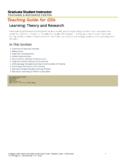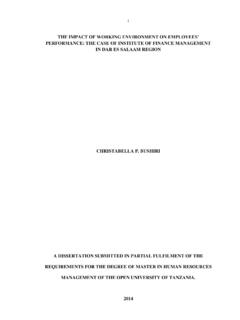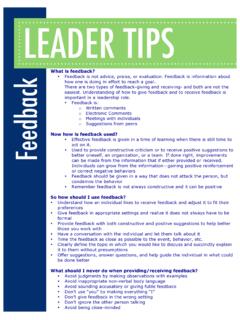Transcription of POSITIVE AND NEGATIVE FEEDBACK MECHANISMS …
1 I:\Secondary\Science\Science Resources\Physics\3 IB\Topic 8- Energy, Power and Climate Change\Resources\ FEEDBACK 1 POSITIVE AND NEGATIVE FEEDBACK MECHANISMS FEEDBACK MECHANISMS either change a system to a new state or return it to its original state. NEGATIVE FEEDBACK MECHANISMS - push a system back to its original equilibrium position Imagine you are out walking in the country. As you walk, the sun rises higher in the sky and the air temperature increases. Your body senses that your internal temperature is rising above 370C and you start to sweat, which reduces your body temperature by evaporating water from your skin, returning your temperature to normal POSITIVE FEEDBACK MECHANISMS push a system to a new state of equilibrium , Imagine you are lost on a high snowy mountain. When your body senses that it is cooling below 370C, various MECHANISMS such as shivering help to raise your internal temperature again, but if these are insufficient to restore normal body temperature, your metabolic processes start to slow down, as, like most chemical reactions, they happen more slowly at lower temperatures.
2 As a result you become lethargic and sleepy and move around less and less, allowing your body to cool even further. Unless you are rescued at this point, your body will reach a new equilibrium you will die of hypothermia. Both natural and human systems are influenced by FEEDBACK MECHANISMS . Generally, we wish to preserve the environment in its original state, so NEGATIVE FEEDBACK is usually helpful and POSITIVE FEEDBACK is usually undesirable. However there are other situations where change is needed and POSITIVE FEEDBACK is advantageous eg if students enjoy their Environmental Systems lessons, they want to learn more, so attend classes regularly and complete assignments. Consequently they move to a new equilibrium of being better educated about the environment. Overleaf there are a number of examples of how both POSITIVE and NEGATIVE FEEDBACK MECHANISMS might operate in the physical environment. No-one can be sure which of these effects is likely to be most influential, and consequently we cannot know whether or not the Earth will manage to regulate its temperature, despite human interference with many natural processes.
3 1. Label each example overleaf as either POSITIVE or NEGATIVE FEEDBACK 2. Draw diagrams of one example of POSITIVE FEEDBACK and one example of NEGATIVE FEEDBACK using the examples given, to show how FEEDBACK affects a system. Include FEEDBACK loops on your diagrams. I:\Secondary\Science\Science Resources\Physics\3 IB\Topic 8- Energy, Power and Climate Change\Resources\ FEEDBACK 2 Examples of possible POSITIVE and NEGATIVE FEEDBACK in physical systems 1. As carbon dioxide levels in the atmosphere rise: Temperature of Earth rises As Earth warms: the rate of photosynthesis in plants increases more carbon dioxide is therefore removed from the atmosphere by plants, reducing the greenhouse effect and reducing global temperatures 2. As Earth warms: Ice cover melts, exposing soil or water Albedo decreases More energy is absorbed by Earth s surface Global temperature rises More ice melts 3.
4 As Earth warms, upper layers of permafrost melt, producing waterlogged soil above frozen ground: Methane gas is released in anoxic environment Greenhouse effect is enhanced Earth warms, melting more permafrost 4. As Earth warms, increased evaporation: Produces more clouds Clouds increase albedo, reflecting more light away from Earth Temperature falls Rates of evaporation fall 5. As Earth warms, organic matter in soil is decomposed faster: More carbon dioxide is released Enhanced greenhouse effect occurs Earth warms further Rates of decomposition increase 6. As Earth warms, evaporation increases: Snowfall at high latitudes increases Icecaps enlarge More energy is reflected by increased albedo of ice cover Earth cools Rates of evaporation fall 7. As Earth warms, polar icecaps melt releasing large numbers of icebergs into oceans: Warm ocean currents such as Gulf stream are disrupted by additional fresh water input into ocean Reduced transfer of energy to poles reduces temperature at high latitudes Icesheets reform and icebergs retreat Warm currents are re-established







